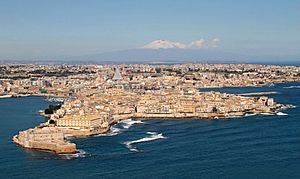Battle of Syracuse (1710) facts for kids
The Battle of Syracuse was an important naval battle that happened on November 9, 1710. It took place near the port of Syracuse on the island of Sicily. This battle was part of a much larger conflict called the War of the Spanish Succession. In this fight, a French fleet arrived to help their merchant ships that were stuck in the harbor. They faced off against British ships that were blocking the port.
Contents
What Was the War of the Spanish Succession?
A Big European Conflict
The War of the Spanish Succession was a major war that lasted from 1701 to 1714. It involved many powerful countries in Europe. The main reason for the war was who would become the next king of Spain. The old king, Charles II, had no children. Before he died, he named a French prince, Philip of Anjou, as his heir.
Who Was Fighting?
Many European countries worried that if a French prince became king of Spain, France would become too powerful. This would upset the balance of power in Europe. So, a group of countries formed an alliance against France and Spain.
- On one side were France and Spain.
- On the other side were Great Britain, the Dutch Republic, Austria, and other smaller states.
The war was fought on land and at sea across Europe and even in North America. The Battle of Syracuse was one of the many naval clashes during this long conflict.
Why Was Syracuse Important?
A Key Port in Sicily
Syracuse is a historic city on the eastern coast of Sicily. It has a natural harbor that was very important for ships in the 18th century. Controlling such ports meant controlling trade routes and naval movements in the Mediterranean Sea.
Blockade of French Ships
During the War of the Spanish Succession, the British navy often tried to stop French ships from moving freely. In 1710, a group of French merchant ships were in Syracuse harbor. These ships were full of valuable goods. The British fleet had set up a blockade outside the harbor. This meant they were trying to prevent the French merchant ships from leaving.
The Battle Unfolds
French Relief Arrives
A French naval commander named Jacques Cassard was sent to help the trapped merchant ships. He was in charge of a fleet of four French warships. His mission was to break the British blockade and allow the French merchant fleet to sail safely to Marseille.
British Fleet is Away
When Cassard's fleet arrived off Syracuse, most of the British blockading fleet was not there. They had left to get supplies and rest at Port Mahon, a naval base. Only two British ships were left behind to keep the blockade going. These ships were HMS Falcon and HMS Pembroke.
A Quick Victory
With most of the British fleet gone, Cassard had a big advantage. He quickly attacked the two remaining British ships. The French forces were stronger and more numerous than the small British force.
- Cassard successfully captured both HMS Falcon and HMS Pembroke.
- This meant the British blockade was broken.
After capturing the British ships, Cassard was able to escort the heavily loaded French merchant fleet out of Syracuse harbor. They then sailed safely to Marseille, a major port in France.
What Happened After the Battle?
Impact of the Battle
The Battle of Syracuse was a relatively small naval engagement. However, it was a success for the French. It showed that even with a smaller force, a well-timed attack could break a blockade. For the British, it was a minor setback, as they lost two ships and failed to keep the French merchant fleet trapped.
War Continues
The War of the Spanish Succession continued for several more years after this battle. It finally ended with the signing of the Treaty of Utrecht in 1713 and the Treaty of Rastatt in 1714. These treaties helped to establish a new balance of power in Europe. Philip of Anjou did become King Philip V of Spain, but he had to give up any claim to the French throne.


